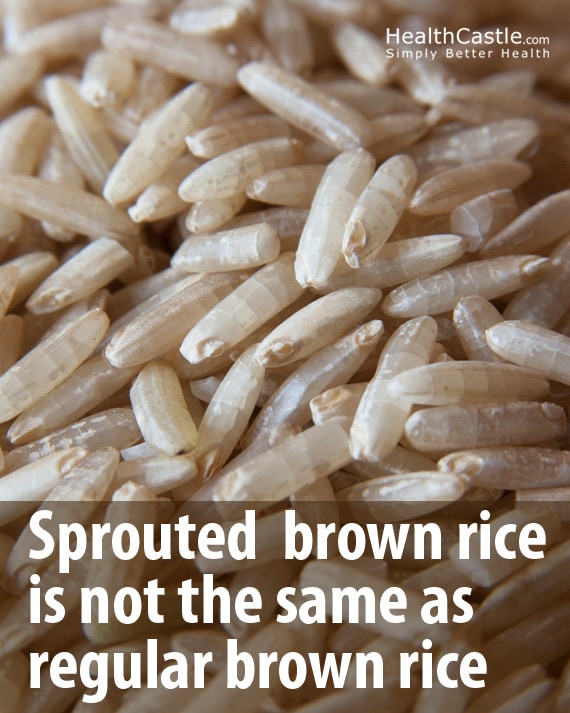
Written By: Gloria Tsang, RD
Title: Founding Registered Dietitian
Alumni: University of British Columbia
Last Updated on:

Are you on a quest to increase the variety of whole grains at your table? If you’re not a big fan of regular brown rice, give sprouted brown rice a try! Sprouted brown rice is exactly that – brown rice that has been allowed to sprout or germinate before packaging.
Other names for sprouted brown rice:

1/4 cup of Now Foods uncooked sprouted brown rice (which yields close to 1 cup cooked) provides:
The process of germination changes the nutritional composition of the rice. While the macronutrient (carbohydrate, protein, and fat) contents and calories of brown rice and sprouted brown rice are similar, sprouted brown rice contains higher levels of gamma-aminobutyric acid (GABA), magnesium, potassium, and zinc, as well as the phytonutrients ferulic acid and gamma oryzanol. This is why sprouted or germinated brown rice is sometimes referred to as “GABA rice.” Note that this doesn’t mean regular brown rice lacks these nutrients; the sprouting process simply makes these nutrients more available. GABA exists in the body as a neurotransmitter in the central nervous system and has an inhibitory or calming effect.
The amino acid GABA, is mostly found in the bran of the grain. Therefore, refined white rice is not a good source while whole grain rice varieties have more
Sprouted brown rice has:
In a 2012 study, researchers looked in the antidiabetic effect of sprouted or germinated brown rice. One of the study measurement was its glycemic index. Sprouted brown rice produced the lowest glycemic index values among 3 types of rice.
| White Rice | Regular Brown Rice | Sprouted Brown Rice | |
| Glycemic Index | 67.4 | 61.5 | 56.9 |
Emerging research on germinated or sprouted brown rice suggests regular consumption has beneficial effects on blood cholesterol and diabetes, and it is also being studied in the prevention of some allergies. Phytonutrients in brown rice, as in many other plant-based foods, have been shown to have antioxidant properties.
As with many whole grains, it is possible to sprout brown rice at home. However, if you are pressed for time, store-bought sprouted brown rice may be more convenient. The sprouted brown rice you buy has been dried after sprouting so it can be stored just as easily as regular brown rice.
In her book Go UnDiet, Gloria Tsang talks about how sprouted brown rice can be an appealing alternative to those who dislike the chewiness of most whole grains. Cooked sprouted brown rice is softer in texture than regular brown rice. In addition, sprouted brown rice can finish cooking within 10 minutes, whereas regular brown rice typically takes about 45 minutes.
Alumni: University of British Columbia – Gloria Tsang is the author of 6 books and the founder of HealthCastle.com, the largest online nutrition network run by registered dietitians. Her work has appeared in major national publications, and she is a regularly featured nutrition expert for media outlets across the country. The Huffington Post named her one of its Top 20 Nutrition Experts on Twitter. Gloria’s articles have appeared on various media such as Reuters, NBC & ABC affiliates, The Chicago Sun-Times, Reader’s Digest Canada, iVillage and USA Today.
brown rice, gaba rice, germinated brown rice, sprouted brown rice
I love this sprouted rice. A few years back I actually sprouted this myself. What a pain! Now it’s more common and reasonably priced so I opt to buy it. Especially since it has been dried after it is sprouted.
Question: what are the general recommendations for daily or weekly consumption of this rice? I am on a weight loss program.
OMG, sprouted short grain brown rice is the best! I sprout it on the counter for about 3 days (depending on the temperature) doing enough for several days and I’ll cook about 1/2 of it and leave the rest in the fridge covered which lasts a good 4 days before it needs to be cooked off. It freezes well too, and of course if you have a dehydrator you can dry it.
I made rice pudding with it lately and what a fantastic evening snack! Not only does the GABA help you sleep, it’s satisfying and tastes like you’re having a treat…